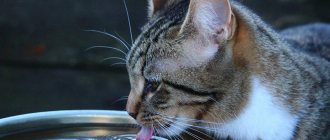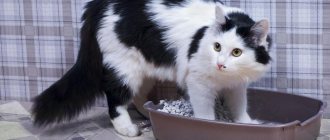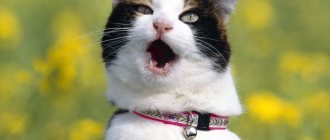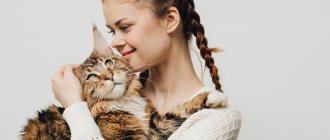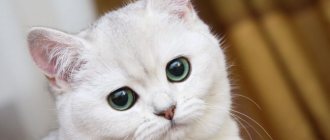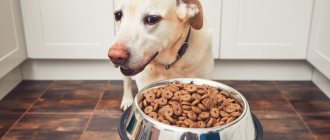Daily fluid intake
According to veterinarians, a cat's daily water intake should be 20-40 milliliters of water per 1 kilogram of weight. For kittens, this figure is doubled or tripled, since the growing body requires more moisture for new cells. For this reason, the diet of animals under three months of age should consist only of wet food.
The indicated rate of water consumption for a cat is average. Deviations are possible due to a number of aspects.
- Feed. If your pet eats only dry food, the amount of water it consumes should be three times the amount of pellets it eats.
- Dimensions. The lower the weight of the animal, the higher its need for fluid per 1 kilogram of body weight.
- Activity . Exclusively indoor cats are usually less active than their counterparts who periodically walk outside, and therefore drink less.
- Pregnancy and lactation. A pregnant or lactating cat needs plenty of fluids. Moisture is needed to produce additional blood, amniotic fluid and milk for kittens.
- Ambient temperature. During the hot season, cats require more fluid due to the increasing load on the thermoregulatory system. They lick themselves vigorously and, thanks to the evaporation of saliva, tolerate the heat more easily. In addition, a certain amount of liquid evaporates from the surface of the mucous membranes when a hot animal breathes with its mouth open.
Which water is the healthiest?
The cat should drink water that will not harm its health. Ordinary tap water does not meet this requirement because it contains too many harmful impurities. Its consumption is fraught with urolithiasis.
It is not recommended to give your cat boiled water - it has a poorer mineral composition than ordinary water. In addition, when boiling, a sediment of solid particles is formed. Their entry into the animal’s body will not benefit it.
Distilled water is strictly contraindicated for your pet. It does not quench thirst and does not linger in the body due to the almost complete absence of any minerals and salts. Mineral water is the other extreme. It is saturated with these substances much more than the cat’s body requires.
Here are the most preferred options.
- Tap water passed through a household filter. This guarantees the absence of most of the harmful impurities.
- Bottled drinking water with the most balanced composition of mineral elements.
How to properly water an animal
Getting your cat to drink more than usual is not that difficult. In the absence of pathologies, the reason for rare trips to watering places lies in improper drinking water or questionable water quality. If you understand each of these points, then you don’t have to worry about the health of your mustachioed pet.
Selection and installation of a drinking bowl or bowl
Choose ceramic or glass bowls. Plastic products often leave an unpleasant odor and quickly accumulate bacteria. If the main material is metal, then it can produce glare that frightens or misleads the animal.
When drinking, a narrow bowl can injure the vibrissae, so it is better to take a wider one.
It is also important not to forget about hygiene: the drinking bowl must be washed daily.
If your animal refuses to drink from a bowl, but loves a stream from the tap, buy him a drinking fountain. This device filters the liquid poured into it and enriches it with oxygen. Another option is to install a faucet filter.
Sometimes the problem lies not in the drinker, but in the place where it is installed. Not all animals like to drink in the kitchen. Place filled containers throughout the house and see which one your cat drinks from most readily. Very often, mustachioed pets prefer the owner's cups left unattended. Be prepared to share your supplies for the sake of your pet's health.
What kind of water to give your cat
Not all owners know what kind of water to give their cat, so they give it straight from the tap or allow it to drink from puddles during the summer season. In the first case, an abundance of salts can lead to the formation of stones and the development of urolithiasis. In the second case, the pet runs the risk of becoming infected with bacteria and viruses that live in stagnant bodies of water.
The best option is bottled or filtered water. It contains a safe amount of salts recommended for normal functioning of the body. Boiling kills all useful elements, so this method of processing does not make sense.
Change the water daily to fresher water. Make sure the amount poured is more than normal. Cats love to save money and keep it in reserve, so this trick will protect them from dehydration.
Deviation from normal fluid intake can lead to unpleasant consequences, so owners need to regularly monitor how much their pets drink. To maintain water balance, use the recommendations discussed above, and if any violations are detected, sign up for an examination at a veterinary clinic.
The article is for informational purposes only. Contact your veterinarian!
Choosing a convenient drinker
Your cat should have access to fresh, clean water around the clock. Make sure that the amount in the bowl is approximately 50% higher than your pet’s daily requirement. This is especially true for animals that eat dry food: the granules swell after ingestion, causing extreme thirst.
It is advisable to pour water into a wide bowl so that the cat does not experience discomfort from the whiskers touching its edges while drinking. A ceramic or glass container is most preferable. In a shiny metal bowl, water can create reflections that will distract or even frighten your cat. If your pet has running water, buy him a drinking fountain.
The water bowl should be washed daily, and in summer - two to three times a day.
What to do if your cat drinks too little or too much
If, after all the tricks, the cat drinks very little (less than 20 ml per 1 kg of weight), it makes sense to check the state of its health or switch to a different type of food, especially if there is a tendency to KSD.
If you notice that your cat has stopped drinking altogether, this is the first sign of pathology. If this is observed within 24 hours, you need to urgently contact a veterinary clinic, otherwise the cat will develop fatal dehydration. Most often, while refusing water, the cat also refuses food, and there are also some additional symptoms - lethargy, diarrhea, vomiting, and so on. When my cat got panleukopenia as a kitten, he didn't drink or eat at all for about five days. We compensated for his lack of nutrients with drips in a veterinary clinic.
If a cat drinks, on the contrary, too much, do not rush to rejoice.
Constant thirst may be a sign of kidney failure or diabetes. If the cat previously drank no more than 150 ml of water and suddenly began to drink 300-500 ml, then you just need to show it to the veterinarian.
A diet that is too low in minerals can also cause a cat to drink excessively. If there is little potassium, magnesium and other important components in the food and the same water, the cat will try to get them by drinking water. Often, if a cat really lacks minerals, she begins to chew the soil in indoor flowers or happily drinks the mineral water offered to her. In this case, it makes sense to think about changing your water and diet in general.
However, if your pet is completely healthy and you have chosen the right food for him, then he will consume the required minimum of liquid. Yes, there are healthy cats, but they drink very little, in this case you need to either experiment with food or switch the animal to a wet diet.
Your cat should drink water every day. There are also a number of questions: what is the amount of water per day for a cat, what to do if the cat drinks a lot of water or does not even go to the bowl? Most of these questions cannot be answered unambiguously, because much depends on the cat itself, its breed, age, health, lifestyle, type of diet and quality of care. However, we can determine the standards that should be followed, and more on this below.
Why does a cat refuse water?
As mentioned above, cats are light-drinking animals. However, sometimes it happens that a pet completely refuses to drink. There may be several reasons.
- Disease. The cat approaches the bowl of water, but does not drink at all or very little. At the same time, he often licks his lips. Perhaps his teeth or gums hurt, problems with the mucous membranes. If a cat frequently uses the litter box, but urinates a little each time, and the urine itself has an unpleasant odor and is mixed with blood, it is possible that the animal suffers from urolithiasis. Lethargy, fever, discharge from the eyes, nose, vomiting are already signs of an infectious disease.
- Stress. Emotional discomfort in a cat can be caused by anything. For example, the noise of renovations from neighbors or the arrival of a large number of guests in your home. A frightened pet can sit in a shelter all day, no thirst will force him to leave the shelter;
- Hormonal surge. During the period of the so-called sexual heat, animals can forget about everything in the world.
- Dissatisfaction with the drinking bowl and water quality.
How to measure how much water a cat drinks per day
Use a measuring cup to measure. Pour into it a little more (allowing for evaporation) of the recommended amount and pour everything into a bowl. At the end of the day, pour the remaining liquid back into the glass and subtract this amount from the original. Be sure to add extra volume if the bowl had to be refilled.
During the experiment, avoid contact with the toilet and taps, where the cat likes to drink from at normal times. For accurate results, extend the measurements by 3 days. Due to external and internal factors, moisture requirements may vary from day to day.
If your family has several pets, they will have to be temporarily separated from each other. Place subjects in different rooms to avoid confusion in calculations.
You can also use a webcam to track the volume you drink on a recording using a measuring cup. To do this you will need a device with high definition images. Otherwise, it will be impossible to notice the change in divisions.
Forced additional soldering
If there is a painful condition, the cat should be taken to the veterinarian. If a healthy pet drinks little, then dehydration of the four-legged body can be prevented by supplementing it with water.
Take a syringe with a volume of 10-20 milliliters, fill with water, and replace the needle with a silicone nozzle. To force the cat to open its mouth, place your palm on its head and press the area behind the fangs with your thumb and forefinger. When the animal opens its jaws, insert the syringe nozzle into the gap and supply water in small portions. The animal's muzzle should be slightly raised, and the syringe should be positioned at an acute angle to the head. The water should not go directly into the throat, but behind the pet’s cheek, otherwise the cat may choke. Make sure he has time to swallow. If your cat coughs, let him catch his breath.
Not all animals take this procedure calmly. If your pet actively resists and uses its claws, swaddle it in a towel, leaving only its head free.
